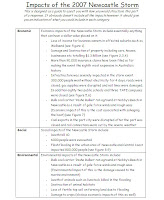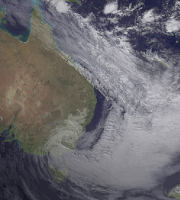Geographic Processes Involved (Think of this as almost like an introduction)
What is a Severe Storm? → How and Why do they form?
Where did the 2007 storm occur? → Indicate this on a map and include latitude and longitude co-ordinates
When did the 2007 Newcastle storm occur? → Try to include a synoptic chart (weather map) and/or satellite photos for when the event occurred
A description of what happened → Important to include relevant statisticsImpact (What / Who was affected by the 2007 Newcastle storm)
Impacts (What/Who was affected? How were they affected?)
Geographers classify the impacts of natural hazards into three main categories:
- Social
- Economic
- Environmental
You can include pictures of the damage / destruction so long as they are labeled and are linked to your writing eg. Figure 1 below highlights the damage the severe storm caused to the Newcastle CBD.
Responses of Individuals, Groups and Government to the Newcastle Storm
- Who provided assistance?
- What was their role? What did they do?
What is a Severe Storm? → How and Why do they form?
Where did the 2007 storm occur? → Indicate this on a map and include latitude and longitude co-ordinates
When did the 2007 Newcastle storm occur? → Try to include a synoptic chart (weather map) and/or satellite photos for when the event occurred
A description of what happened → Important to include relevant statisticsImpact (What / Who was affected by the 2007 Newcastle storm)
Impacts (What/Who was affected? How were they affected?)
Geographers classify the impacts of natural hazards into three main categories:
- Social
- Economic
- Environmental
You can include pictures of the damage / destruction so long as they are labeled and are linked to your writing eg. Figure 1 below highlights the damage the severe storm caused to the Newcastle CBD.
Responses of Individuals, Groups and Government to the Newcastle Storm
- Who provided assistance?
- What was their role? What did they do?








